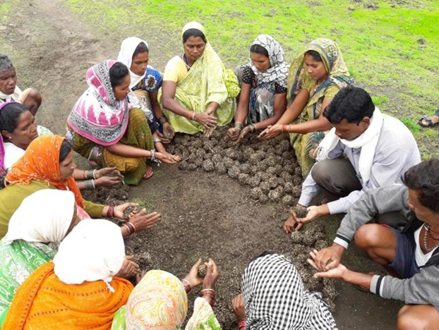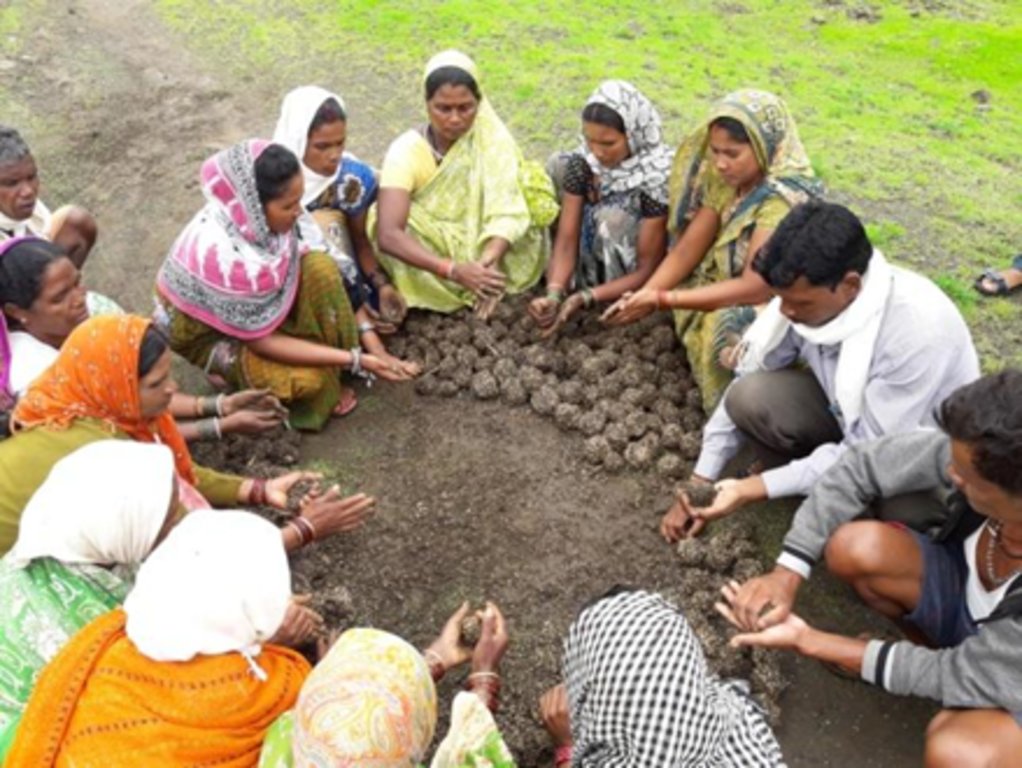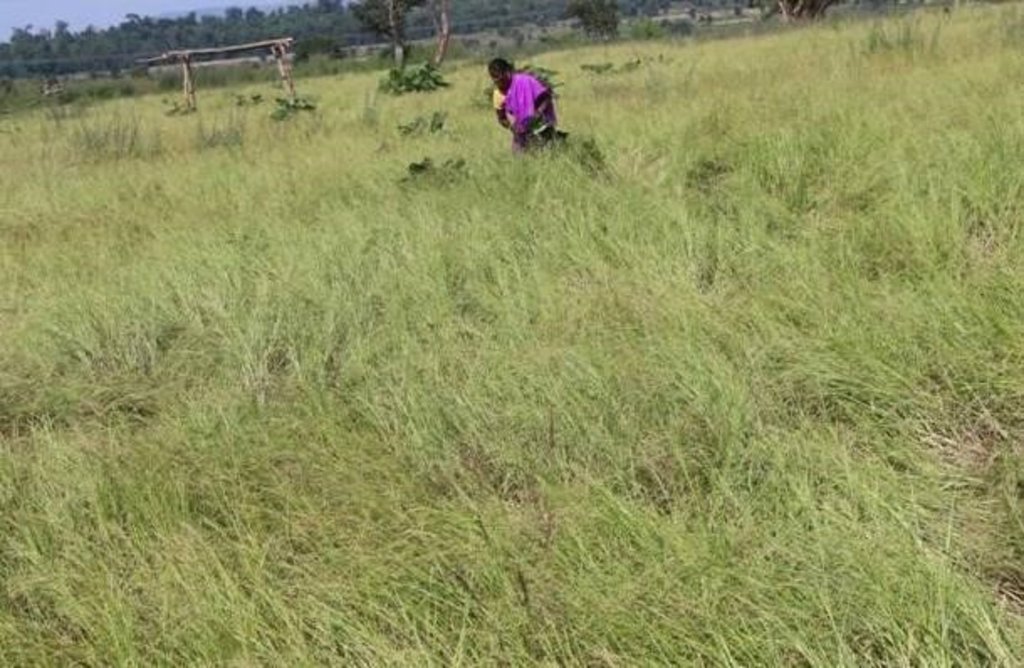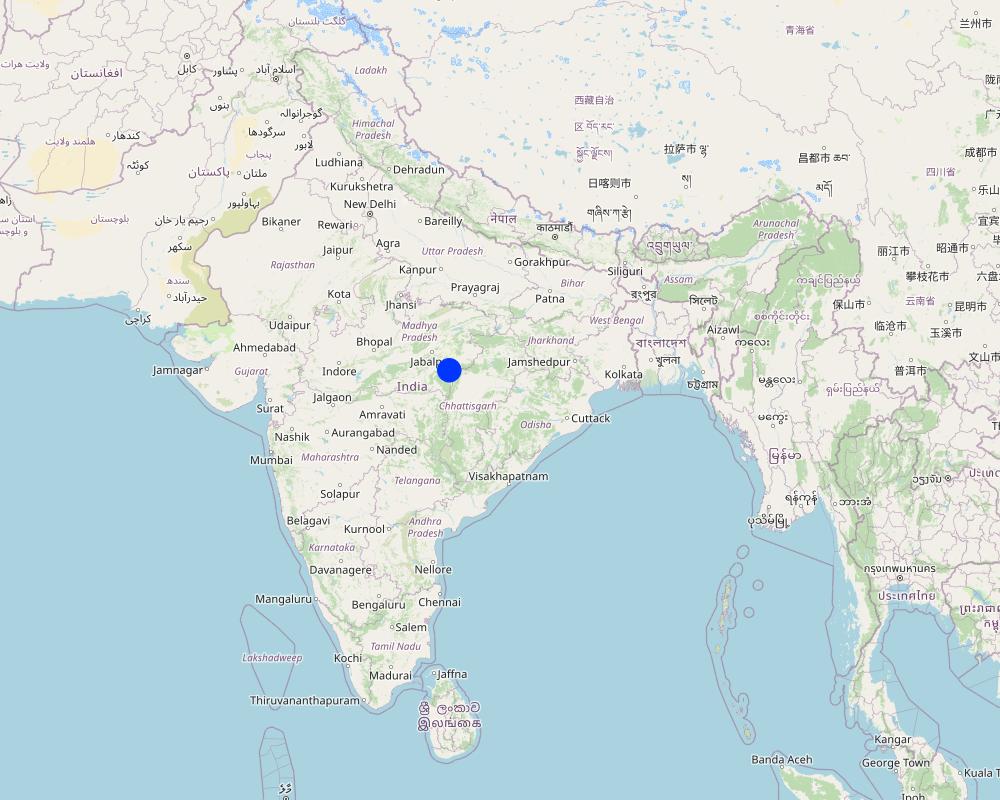Community Based Soil Rehabilitation for Grassland on Common Lands After Erdadication of the Invasive Lantana Camara [印度]
- 创建:
- 更新:
- 编制者: Santosh Gupta
- 编辑者: Noel Templer, Stephanie Katsir, Kim Arora, Tabitha Nekesa, Ahmadou Gaye, Siagbé Golli
- 审查者: Udo Höggel, Joana Eichenberger, Sally Bunning
technologies_6689 - 印度
- Community Based Soil Rehabilitation for Grassland on Common Lands After Erdadication of the Invasive Lantana Camara: June 25, 2023 (inactive)
- Community Based Soil Rehabilitation for Grassland on Common Lands After Erdadication of the Invasive Lantana Camara: April 11, 2024 (inactive)
- Community Based Soil Rehabilitation for Grassland on Common Lands After Erdadication of the Invasive Lantana Camara: Sept. 14, 2023 (inactive)
- Community Based Soil Rehabilitation for Grassland on Common Lands after Eradication of the Invasive Lantana Camara: May 30, 2024 (public)
查看章节
全部展开 全部收起1. 一般信息
1.2 参与该技术评估和文件编制的资源人员和机构的联系方式
有助于对技术进行记录/评估的项目名称(如相关)
Soil protection and rehabilitation for food security (ProSo(i)l)有助于对技术进行记录/评估的机构名称(如相关)
GIZ India (GIZ India) - 印度有助于对技术进行记录/评估的机构名称(如相关)
Alliance Bioversity and International Center for Tropical Agriculture (Alliance Bioversity-CIAT) - 肯尼亚有助于对技术进行记录/评估的机构名称(如相关)
Ecociate Consultants (Ecociate Consultants) - 印度1.3 关于使用通过WOCAT记录的数据的条件
编制者和关键资源人员接受有关使用通过WOCAT记录数据的条件。:
是
1.4 所述技术的可持续性声明
这里所描述的技术在土地退化方面是否存在问题,导致无法被认为是一种可持续的土地管理技术?:
否
注释:
The technology described is aimed at restoring community land by controlling the spread of the invasive plant species known as Lantana Camara
2. SLM技术的说明
2.1 技术简介
技术定义:
Community-based soil rehabilitation by eradicating the invasive plant Lantana Camara using the 'cut rootstock' method (refer to WOCAT technology 6660) is an effective, cost-efficient, and sustainable approach to restoring grasslands on common lands in the Mandla District of Madhya Pradesh. The three-tier institutional structure used in this eradication process involved the formation of informal women groups at the hamlet level (village organisational structure), the Village Environment Committee (VEC) at the village level, and an Executive Committee at the cluster level (higher organisational structure) so to ensure community involvement and ownership.
2.2 技术的详细说明
说明:
Community-based soil rehabilitation after the eradication of the invasive plant species, Lantana Camara, is an effective technique for restoring grasslands on common lands that had earlier been invaded by this species. The invasion of Lantana Camara can have significant negative impacts on the ecosystem, reducing the diversity of plant life and disrupting the local communities' use of common lands for grazing, for agriculture, and for collecting non-timber forest products.
To address these issues, a three-tier institutional structure is being used by the project-implementing organization Foundation for Ecological Security (FES). This structure includes the formation of informal women groups at the hamlet level, the Village Environment Committee (VEC) at the village level, and an executive committee at the cluster level. The VEC prepares proposals on common issues and plans with budgets that are presented to the executive committee, which is made up of a mix of individuals, with 50% of the seats reserved for women.
The first step in the process is for the village executive committee to take the Gram Sabha (Village Governing Body) into confidence and prepare bylaws for the restoration and conservation of the Lantana-eradicated site. These bylaws are regularly discussed in the village institution meeting to refresh the memory of the community and different stakeholders on how to properly conserve the site. Local resource persons facilitate the implementation of work.
One of the major works undertaken by these communities in the Mandla District is the soil rehabilitation from Lantana Camara for grassland restoration on common lands. The uprooting of Lantana is a tricky process, and improper methods can result in an even more forceful recurrence of the species. Therefore, the "cut rootstock" method is used, which involves cutting the root of the plant three inches below the ground and lifting the bush upside down to prevent it from gaining ground. This method is done between July and September before fruiting to avoid seed fall, which can cause recurrence for up to three years, also this is the time when the soil has enough moisture thus softness to uproot the Lantana plants.
The Cut Rootstock (CRS) method to control the spread of Lantana Camara is cost-effective and sustainable as it does not require the use of chemical herbicides or heavy machinery. In addition to using the CRS method, perching trees are located, and saplings are removed from under their canopies and along the nearby surface runoff zone. Regular monitoring and follow-up actions may be necessary to ensure the long-term success of this method in controlling the spread of Lantana Camara.
To prevent a recurrence, measures such as mopping for three years continuously, planting and seed sowing in areas where rootstocks seem to be less, and grass seed sowing are executed. The community institution ensures the collection of indigenous grass species, which are made into seed balls and sown before the advent of monsoon. These grass seeds germinate and grow in the rainy season, reducing the suitable environment for Lantana seed germination. Revegetation measures involve selecting and planting grazing hardy, fire hardy, and water hardy tree species such as bamboo, Khameer, Java Plum, Karanj (Pongame oil tree), Aonla, Harra, and other non-timber forest product-producing tree species. These plants are selected to create a three-tiered forest and sustainably provide food, fuel wood, and fodder. Once established, they do not allow Lantana to grow.
Biomass assessment is undertaken every year to assess the improvement in the status of the biomass in the plot, and the findings are shared with the community to motivate them to follow the rules and regulations formulated by the village institution. Cut and carry practices are allowed from the second year, but open grazing is prohibited, and Lantana eradication from nearby areas is required while cutting the grass. This helps to bring Lantana under control while sustainably utilizing the grass resources.
This initiative has ensured access to common lands for the local communities, access to fodder and green grass for livestock and the emergence of biodiversity in the area. This initiative is well recognised by Government institutions and policy makers.
2.3 技术照片
2.5 已应用该技术的、本评估所涵盖的国家/地区/地点
国家:
印度
区域/州/省:
Madhya Pradesh
有关地点的进一步说明:
Village: Changaniya, Block- Bichhiya, Mandla
具体说明该技术的分布:
- 适用于特定场所/集中在较小区域
技术现场是否位于永久保护区?:
否
注释:
The technology is applied on common lands viz. common grazing land, forest, Gram Panchayat land
Map
×2.6 实施日期
注明实施年份:
2016
2.7 技术介绍
详细说明该技术是如何引入的:
- 在实验/研究期间
- 通过项目/外部干预
注释(项目类型等):
FES has done extensive research and studies to find out the appropriate technologies and approaches to remove the Lantana plants and rehabilitate the soil by restoring grasslands
3. SLM技术的分类
3.1 该技术的主要目的
- 改良生产
- 减少、预防、恢复土地退化
- 保护生态系统
- 创造有益的经济影响
- 创造有益的社会影响
3.2 应用该技术的当前土地利用类型
同一土地单元内混合使用的土地::
是
具体说明混合土地使用(作物/放牧/树木):
- 林牧业

牧场
粗放式放牧:
- 季节性迁移的放牧主义
集约放牧/饲料生产:
- 收割和携带/零放牧
- 改良牧场
- Eradication of Lantana and restoring the grasslands
动物类型:
- 水牛
- 牛 - 奶制品
- 山羊
是否实行作物与牲畜的综合管理?:
否
产品和服务:
- economic security, investment prestige
品种:
水牛
品种:
牛 - 奶制品
品种:
山羊

森林/林地
- (半天然)天然森林/林地
(半天然)天然森林/林地:具体说明管理类型:
- 清除枯木/剪枝
- 非木材森林的利用
以上的树木是落叶树还是常绿树?:
- 落叶植物
产品和服务:
- 薪材
- 水果和坚果
- 放牧/啃牧
- 自然保持/保护
注释:
The common land in villages which is generally not maintained, so allowing for the growth of invasive species, and unregulated open grazing is restored by the local community in a participatory manner for common benefits.
3.3 由于技术的实施,土地使用是否发生了变化?
由于技术的实施,土地使用是否发生了变化?:
- 是(请在技术实施前填写以下有关土地利用的问题)
同一土地单元内混合使用的土地::
是
具体说明混合土地使用(作物/放牧/树木):
- 林牧业

牧场
粗放式放牧:
- 季节性迁移的放牧主义
集约放牧/饲料生产:
- 收割和携带/零放牧
- After restoration of common land, grasses are allowed to grow
是否实行作物与牲畜的综合管理?:
否

森林/林地
- Common village land and fringe areas of forests
- Indigenous grass restoration on common lands
以上的树木是落叶树还是常绿树?:
- 落叶植物
产品和服务:
- 薪材
- 水果和坚果
- 其它森林产品
- 放牧/啃牧
- 自然保持/保护
注释:
The common lands are restored to grasslands in a participatory manner
3.4 供水
该技术所应用土地的供水:
- 雨养
注释:
Mandla is a predominantly rainfed district of Madhya Pradesh, with agriculture being the mainstay of the local economy. The District receives an average annual rainfall of around 1280 mm, with the monsoon season being the primary source of precipitation.
3.5 该技术所属的SLM组
- 区域封闭(停止使用,支持恢复)
- 畜牧业和牧场管理
- 改良的地面/植被覆盖
3.6 包含该技术的可持续土地管理措施

植物措施
- V4:更换或清除外来/入侵物种

管理措施
- M1:改变土地使用类型
- M5:物种组成的控制/变化
注释:
Invasive species are removed and the land and soil are rehabilitated by promoting the growth of indigenous grasses. During the first year, no grazing is allowed. In the second year of restoration only manual cutting/carry of grasses is permitted.
3.7 该技术强调的主要土地退化类型

生物性退化
- Bc:植被覆盖的减少
- Bq:数量/生物量减少
- Bf:火灾的有害影响
- Bs:质量和物种组成/多样性的下降
- Bl:土壤寿命损失
注释:
Lantana has several disadvantages including being unpalatable, hindering the growth of other species, reducing the collection of NTFPs (non-timber forest products), and causing soil infertility and erosion. It also provides shelter to wild boar and tigers, leading to human and cattle conflict, and catching fire. Additionally, it has a hard seed cover and can remain dormant for up to 30 years, making eradication difficult.
3.8 防止、减少或恢复土地退化
具体数量名该技术与土地退化有关的目标:
- 减少土地退化
- 修复/恢复严重退化的土地
4. 技术规范、实施活动、投入和成本
4.1 该技术的技术图纸
技术规范(与技术图纸相关):
Drawing of this technology does not require as there no technical structure being build as part of the intervention. The images indicated a rehabilitated field after the eradication of Lantana.
4.2 有关投入和成本计算的一般信息
具体说明成本和投入是如何计算的:
- 每个技术区域
注明尺寸和面积单位:
1
如果使用本地面积单位,注明转换系数为1公顷(例如1公顷=2.47英亩):1公顷=:
ha
其它/国家货币(具体说明):
INR (2023 April)
如相关,注明美元与当地货币的汇率(例如1美元=79.9巴西雷亚尔):1美元=:
82.12
注明雇用劳工的每日平均工资成本:
204
4.3 技术建立活动
| 活动 | 时间(季度) | |
|---|---|---|
| 1. | Removal of lantana | September-October (After Monsoon) |
| 2. | Preparation of seeds for sowing | Before the onset of Monsoon |
| 3. | Sowing of seeds | Just before the onset of monsoon or during the monsoon (June/July) |
注释:
The cost for Lantana eradication is being shared between the community institution and project
4.4 技术建立所需要的费用和投入
| 对投入进行具体说明 | 单位 | 数量 | 单位成本 | 每项投入的总成本 | 土地使用者承担的成本% | |
|---|---|---|---|---|---|---|
| 劳动力 | Removal of lantana | ha | 1.0 | 7229.0 | 7229.0 | 20.0 |
| 劳动力 | Land preparation for plantation | Person day | 1.0 | 200.0 | 200.0 | 100.0 |
| 劳动力 | Sowing of seeds | Person days | 2.0 | 200.0 | 400.0 | 100.0 |
| 设备 | Land preparation for plantation | ha | 1.0 | 1000.0 | 1000.0 | 50.0 |
| 植物材料 | Seeds or planting material | Ha | 1.0 | 1000.0 | 1000.0 | 50.0 |
| 植物材料 | Cow dung and compost material | Ha | 1.0 | 2500.0 | 2500.0 | 100.0 |
| 技术建立所需总成本 | 12329.0 | |||||
| 技术建立总成本,美元 | 150.13 | |||||
如果土地使用者负担的费用少于100%,请注明由谁负担其余费用:
The remaining cost is being covered by the project funds routed through community participation.
注释:
The cost varies based on the density of lantana in the field. Depending on density, it varies from Rs 7729 per ha to Rs 2808 per ha. The work is done in a participatory manner by the local community. For the removal of the Lantana project funds routed, the plantation of indigenous grass seeds, curbing the regrowth of Lantana Camara, etc work is undertaken by the local community.
4.5 维护/经常性活动
| 活动 | 时间/频率 | |
|---|---|---|
| 1. | Regular monitoring of the plantation area | July to November |
| 2. | Application of compost | June-July |
注释:
Lantana Camara is a persistent weed, and even after complete eradication from common lands, its seeds can remain viable in the soil for a prolonged period. Therefore, it is essential to monitor the area regularly and prevent re-growth at the initial stage in the next few years.
Since the community works together on common lands in a participatory manner, there is very little maintenance cost involved in the process.
The density of lantana in the field can be categorized into three levels based on the number of bushes per area. A density of more than 1500 bushes per area is considered high density, while a density between 500-1500 is classified as moderately dense. A density of fewer than 500 bushes per area is known as low density.
4.6 维护/经常性活动所需要的费用和投入(每年)
| 对投入进行具体说明 | 单位 | 数量 | 单位成本 | 每项投入的总成本 | 土地使用者承担的成本% | |
|---|---|---|---|---|---|---|
| 劳动力 | Monitoring of plantation area | Person days | 12.0 | 200.0 | 2400.0 | 100.0 |
| 植物材料 | Application of compost | Ha | 1.0 | 2000.0 | 2000.0 | 100.0 |
| 技术维护所需总成本 | 4400.0 | |||||
| 技术维护总成本,美元 | 53.58 | |||||
如果土地使用者负担的费用少于100%,请注明由谁负担其余费用:
The Project and other Government agencies support by providing the planting material
注释:
This being a community-based approach a lot of activities are being done in a participatory way without the involvement of monetary transactions
4.7 影响成本的最重要因素
描述影响成本的最决定性因素:
The density of lantana in the field is categorized into 3: more than 1500 bushes are considered high density, and between 500-1500 are considered moderately dense, while less than 500 is known as lowly dense. Such categories have a decicive impact on the costs.
5. 自然和人文环境
5.1 气候
年降雨量
- < 250毫米
- 251-500毫米
- 501-750毫米
- 751-1,000毫米
- 1,001-1,500毫米
- 1,501-2,000毫米
- 2,001-3,000毫米
- 3,001-4,000毫米
- > 4,000毫米
指定年平均降雨量(若已知),单位为mm:
1427.70
有关降雨的规范/注释:
Monsoon season is June-September which has the majority of the rainfall
注明所考虑的参考气象站名称:
District at glance report of Ministry of Water Resources, Central Groundwater Board, North Central Region BHOPAL, 2013
农业气候带
- 半湿润
- 半干旱
The National Bureau of Soil Survey & Land Use Planning (NBSS&LUP) developed twenty agroecological zones based on the growing period as an integrated criterion of adequate rainfall and soil groups. It delineated boundaries adjusted to District boundaries with a minimal number of regions. Mandla District of Madhya Pradesh lies in a hot subhumid ecoregion with red and black soil.
Precepitation - 1000–1500mm; Potential Evapotranspiration -1300–1500 mm; Lenght of Growing Period-150–180days
5.2 地形
平均坡度:
- 水平(0-2%)
- 缓降(3-5%)
- 平缓(6-10%)
- 滚坡(11-15%)
- 崎岖(16-30%)
- 陡峭(31-60%)
- 非常陡峭(>60%)
地形:
- 高原/平原
- 山脊
- 山坡
- 山地斜坡
- 麓坡
- 谷底
垂直分布带:
- 0-100 m a.s.l.
- 101-500 m a.s.l.
- 501-1,000 m a.s.l.
- 1,001-1,500 m a.s.l.
- 1,501-2,000 m a.s.l.
- 2,001-2,500 m a.s.l.
- 2,501-3,000 m a.s.l.
- 3,001-4,000 m a.s.l.
- > 4,000 m a.s.l.
说明该技术是否专门应用于:
- 不相关
关于地形的注释和进一步规范:
The project area is hilly and forested (Satpura Hill Range) and highly undulating with narrow strips of cultivated plains in the valley portion of the river. The plateau is in the northern part, formed by basalt and east-west trending hill in the southern region. The highest elevation is 934 m amsl in the northern part, and the lowest elevation is around 400 m amsl in the northwestern part of the area. Protected forest areas cover the majority of the site in the District as part of the Kanha National Park.
5.3 土壤
平均土层深度:
- 非常浅(0-20厘米)
- 浅(21-50厘米)
- 中等深度(51-80厘米)
- 深(81-120厘米)
- 非常深(> 120厘米)
土壤质地(表土):
- 粗粒/轻(砂质)
- 中粒(壤土、粉土)
土壤质地(地表以下> 20厘米):
- 中粒(壤土、粉土)
- 细粒/重质(粘土)
表土有机质:
- 低(<1%)
如有可能,附上完整的土壤描述或具体说明可用的信息,例如土壤类型、土壤酸碱度、阳离子交换能力、氮、盐度等。:
Soil Testing Parameter status (Average) 2017-20 for the project areas is as follows. This data is based on the soil samples tested by the FES in its soil labs from the project villages.
Soil pH:- 5.906548628; EC (electrical conductivity):- 0.122993577; Soil Organic Carbon:- 0.83%; Nitrogen. :- 293.3696598; Phosphorus:- 25.77762582; Potassium (K):- 139.6696636; Sulphur (S):-18.93457993; Zinc (Zn):- 0.955246706; Boron (Bn):- 0.490850376
5.4 水资源可用性和质量
地下水位表:
5-50米
地表水的可用性:
中等
水质(未处理):
不良饮用水(需要处理)
水质请参考::
地下水和地表水
水的盐度有问题吗?:
否
该区域正在发生洪水吗?:
否
关于水质和水量的注释和进一步规范:
The groundwater status is within the safe limits as per the reports by the Government of Madhya Pradesh. People use water from rivers, streams, and traditional small wells for domestic purposes. In the absence of good vegetative cover, the rainwater washes off the fertile topsoil from the farmlands making the land barren and resulting in the siltation of ponds and other water bodies. Further, a heavy infestation of invasive species such as Lantana Camara compounds the degradation. The studied block Bichhiya is in a better position in terms of stage of groundwater development with 17%, while the average of the district is 7%. (stage of groundwater development refers to the % of groundwater being used for various purposes from the available groundwater in that area e.g. net annual groundwater availability in Bichhiya block is 9087 ham (hectare meters) while the existing annual ground water draft for all usage is 1523 ham, making it a 17% groundwater development stage)
Source: http://cgwb.gov.in/District_Profile/MP/Mandla.pdf
5.5 生物多样性
物种多样性:
- 高
栖息地多样性:
- 高
关于生物多样性的注释和进一步规范:
The area is surrounded by Kanha National Park and Phen Wildlife Sanctuary, with a good presence of forest area. World famous Kanha Tiger Reserve is situated in the Mandla District. Kanha is famous for Tiger and Barasingha. Kanha has numerous species of insects, butterflies, reptiles, fishes, and other lesser life forms. Important mammals, birds, reptiles, crustaceans, amphibians, insects, mollusks, and fishes are found in Kanha National Park. The faunal diversity of the district represents 32 wild animals, 63 birds, 4 fishes, and 9 reptile species, respectively. Regarding floral diversity, out of 1006 plant species available in the district, 162 are tree species, followed by 71 species of shrubs, 681 species of herbs, 51 species of climbers, 39 species of grasses, and 2 species of parasites. Mandla is richer in herbaceous species than other adjoining districts like Jabalpur and Seoni.
Source:- Documentation of Biodiversity Status in Mandla District of Madhya Pradesh.
https://mpsbb.mp.gov.in/completedProject/MB.pdf
5.6 应用该技术的土地使用者的特征
定栖或游牧:
- 定栖的
生产系统的市场定位:
- 混合(生计/商业)
非农收入:
- > 收入的50%
相对财富水平:
- 贫瘠
- 平均水平
个人或集体:
- 个人/家庭
- 团体/社区
机械化水平:
- 手工作业
- 畜力牵引
性别:
- 女人
- 男人
土地使用者的年龄:
- 青年人
- 中年人
说明土地使用者的其他有关特征:
The majority of the landusers belong to the tribal community, including some households from an ethnic community called Baiga.
https://en.wikipedia.org/wiki/Baiga_tribe
5.7 应用该技术的土地使用者使用的平均土地面积
- < 0.5 公顷
- 0.5-1 公顷
- 1-2 公顷
- 2-5公顷
- 5-15公顷
- 15-50公顷
- 50-100公顷
- 100-500公顷
- 500-1,000公顷
- 1,000-10,000公顷
- > 10,000公顷
这被认为是小规模、中规模还是大规模的(参照当地实际情况)?:
- 小规模的
5.8 土地所有权、土地使用权和水使用权
土地所有权:
- 社区/村庄
- 个人,有命名
土地使用权:
- 个人
用水权:
- 社区(有组织)
土地使用权是否基于传统的法律制度?:
是
具体说明:
The concerned authorities have issued landowners the land certificates.
注释:
Communities have the legal rights for land ownership and other resources. The mentioned intervention is being undertaken on the commons, having legal rights of local self-governance institutions like Gram Panchayat or Joint Forest Management Committees.
5.9 进入服务和基础设施的通道
健康:
- 贫瘠
- 适度的
- 好
教育:
- 贫瘠
- 适度的
- 好
技术援助:
- 贫瘠
- 适度的
- 好
就业(例如非农):
- 贫瘠
- 适度的
- 好
市场:
- 贫瘠
- 适度的
- 好
能源:
- 贫瘠
- 适度的
- 好
道路和交通:
- 贫瘠
- 适度的
- 好
饮用水和卫生设施:
- 贫瘠
- 适度的
- 好
金融服务:
- 贫瘠
- 适度的
- 好
注释:
Parts of the District suffer from poor road and transportation network
6. 影响和结论性说明
6.1 该技术的现场影响
社会经济效应
生产
饲料生产
注释/具体说明:
From the second year onwards after the restoration of the grassland, the grass can be made available for cattle through a cut and feed method. This involves cutting the grass in a controlled manner and providing it to the cattle as feed. By using this method, the grass can be harvested at its optimum stage of growth, and the cattle can be provided with high-quality feed throughout the year. Additionally, this method allows for better utilization of the grass, minimizing any waste or overgrazing of the grassland.
畜牧生产
注释/具体说明:
Availability of fodder to villages from common lands
土地管理
注释/具体说明:
Lantana Camara is a problematic weed that has many disadvantages. It can reduce biodiversity, decrease soil fertility, and impede the growth of other plant species. Moreover, it can also be toxic to livestock and humans if ingested.
The restoration of grasslands and the eradication of lantana can help in land management. By removing the weed, the growth of other plant species can be promoted, leading to increased biodiversity and improved soil fertility. The removal of lantana can also help to reduce the risk of wildfires, as it is known to be a highly flammable plant.
其它社会经济效应
Restoration of grassland and regulating the use of indigenous grasses as fodder for cattle
注释/具体说明:
The restoration of grassland and regulation of indigenous grasses for cattle fodder can benefit villagers both socially and economically. Socially, it promotes community involvement and ownership of the land, while promoting sustainable land use practices benefit the environment and community. Economically, the restoration provides a sustainable source of income through the sale of milk and meat products, and eco-tourism can help to boost the local economy.
生态影响
土壤
土壤覆盖层
注释/具体说明:
Lantana is known to release allelopathic compounds into the soil, which can inhibit the growth of other plant species. By removing Lantana, the negative impact of these compounds on the soil are reduced, which can promote the growth of a wider range of plants.
生物多样性:植被、动物
植被覆盖
注释/具体说明:
Diversified vegetation cover supports land restoration
植物多样性
外来入侵物种
动物多样性
减少气候和灾害风险
火灾风险
注释/具体说明:
Eradicating Lantana Camara reduces the risk of wildfires as it is highly flammable and provides a significant fuel source. Removing Lantana reduces the fuel source for fires, especially in areas prone to wildfires or near human settlements. Moreover, removing Lantana can promote the growth of more fire-resistant plant species, creating a more resilient ecosystem that can better withstand natural disasters.
对现场影响的评估(测量)进行具体说明:
All of the impact areas indicated in the document are based on the discussions with community members, community institutions and project implementing teams. However, a detailed scientific assessment has not taken place so far.
6.2 该技术的场外影响已经显现
对邻近农田的破坏
注释/具体说明:
The spread of Lantana Camara seeds was reduced within neighboring fields
6.3 技术对渐变气候以及与气候相关的极端情况/灾害的暴露和敏感性(土地使用者认为的极端情况/灾害)
气候有关的极端情况(灾害)
气候灾害
| 该技术是如何应对的? | |
|---|---|
| 森林火灾 | 非常好 |
| 陆地火灾 | 非常好 |
注释:
All of the impact areas indicated in the document are based on the discussions with community members, community institutions and project implementing teams. However, a detailed scientific assessment has not taken place so far.
6.4 成本效益分析
技术收益与技术建立成本相比如何(从土地使用者的角度看)?
短期回报:
积极
长期回报:
非常积极
技术收益与技术维护成本/经常性成本相比如何(从土地使用者的角度看)?
短期回报:
非常积极
长期回报:
非常积极
注释:
Overall, this is a very cost effective technology without having any negative impact on the human and the natural environment
6.5 技术采用
- 1-10%
如若可行,进行量化(住户数量和/或覆盖面积):
On more than 100 locations common land locations this work has been undertaken
在所有采用这项技术的人当中,有多少人是自发的,即未获得任何物质奖励/付款?:
- 0-10%
注释:
This being a relatively new intervention, spontaneous adoption will take some time
6.6 适应
最近是否对该技术进行了修改以适应不断变化的条件?:
否
6.7 该技术的优点/长处/机会
| 土地使用者眼中的长处/优势/机会 |
|---|
| Eradication of Lantana Camara reduces its spread and provided access into the forest areas |
| The common lands are restored to grasslands |
| Fodder available for cattle |
| 编制者或其他关键资源人员认为的长处/优势/机会 |
|---|
| Rehabilitation of the soil by eradication of Lantana Camara |
| Sustainable use of common resources for the purpose of biodiversity restoration |
| A participatory approach for resolving common issues |
6.8 技术的弱点/缺点/风险及其克服方法
| 土地使用者认为的弱点/缺点/风险 | 如何克服它们? |
|---|---|
| Continuous monitoring of the regrowth of Lantana Camara as the seeds stay dormant in the soil for many years | Monitoring, and promoting growth with indigenous grasses, local trees, etc. so that the land is not kept fallow |
| Conflict among the members of community institutions for the management of the common property resources | Handholding and training of community institutions |
| 编制者或其他关键资源人员认为的弱点/缺点/风险 | 如何克服它们? |
|---|---|
| Currently, the program funds the eradication of Lantana Camara undertaken by the local community | Including the work under Mahatma Gandhi National Rural Employment Guarantee Act 2005 or MGNREGA |
| Mechanism to scale up the program participatory approach to manage common land resources | Integrating it with other government schemes |
7. 参考和链接
7.1 信息的方法/来源
- 实地考察、实地调查
10
- 与土地使用者的访谈
5
- 根据报告和其他现有文档进行编译
2
(现场)数据是什么时候汇编的?:
22/02/2023
注释:
During the field visit along with visiting the sites, discussions were held with community institutions, community members, the project implementing agency and other concerned stakeholders to understand the processes, impacts, challenges and future plans
7.2 参考可用出版物
标题、作者、年份、ISBN:
Ecological Restoration of Lantana-Invaded Landscapes in Corbett Tiger Reserve, India Suresh Babuy Amit Love and Cherukuri Raghavendra Babu
可以从哪里获得?成本如何?
https://www.jstor.org/stable/43441335
标题、作者、年份、ISBN:
Impacts of biochar application on upland agriculture: A review Kumuduni Niroshika Palansooriyaa,1, Yong Sik Oka,1, Yasser Mahmoud Awada, Sang Soo Leeb, Jwa-Kyung Sungc, Agamemnon Koutsospyrosd, Deok Hyun Moone,∗
可以从哪里获得?成本如何?
https://pubmed.ncbi.nlm.nih.gov/30616189/
7.3 链接到网络上的相关信息
标题/说明:
Lantana Demo Video
URL:
https://www.youtube.com/watch?v=1d80KyKPkDo
链接和模块
全部展开 全部收起链接
无链接
模块
无模块







